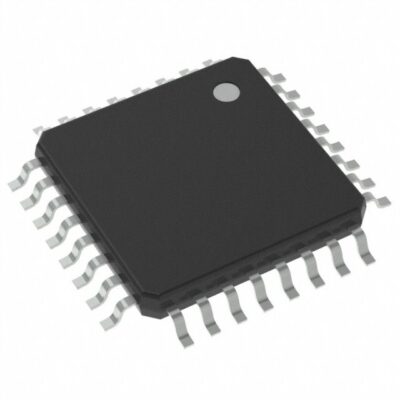ATmega88PA-AU
Part Number: ATmega88PA-AU
Manufacturer: Microchip Technology
Description: IC MCU 8BIT 8KB FLASH 32TQFP
Shipped from: Shenzhen/HK Warehouse
Stock Available: Check with us
ICRFQ.com - Electronic Components Distributor in China Since 2003

Part Number: ATmega88PA-AU
Manufacturer: Microchip Technology
Description: IC MCU 8BIT 8KB FLASH 32TQFP
Shipped from: Shenzhen/HK Warehouse
Stock Available: Check with us
| Datasheet | |
|---|---|
| Category | Integrated Circuits (ICs) |
| Family | Embedded – Microcontrollers |
| Manufacturer | Atmel |
| Series | AVR? ATmega |
| Packaging | Tray |
| Part Status | Active |
| Core Processor | AVR |
| Core Size | 8-Bit |
| Speed | 20MHz |
| Connectivity | I2C, SPI, UART/USART |
| Peripherals | Brown-out Detect/Reset, POR, PWM, WDT |
| Number of I/O | 23 |
| Program Memory Size | 8KB (4K x 16) |
| Program Memory Type | FLASH |
| EEPROM Size | 512 x 8 |
| RAM Size | 1K x 8 |
| Voltage – Supply (Vcc/Vdd) | 1.8 V ~ 5.5 V |
| Data Converters | A/D 8x10b |
| Oscillator Type | Internal |
| Operating Temperature | -40°C ~ 85°C (TA) |
| Package / Case | 32-TQFP |
| Supplier Device Package | 32-TQFP (7×7) |
Microcontrollers have changed the field of electronics by making solutions that are small, flexible, and efficient for a wide range of uses. The Atmel ATmega88PA-AU is a great low-power CMOS 8-bit microcontroller built on the AVR® enhanced RISC architecture. It stands out in this field. In this thorough guide, we’ll get into the details of the ATmega88PA-AU microcontroller, looking at its features, powers, and possible uses. Whether you’re an experienced creator of embedded systems or new to the world of microcontrollers, this guide will give you the information you need to use the ATmega88PA-AU to its fullest.
The ATmega88PA-AU microcontroller boasts an array of features that make it a standout choice for developers and engineers:
The AVR-enhanced RISC design is the heart of ATmega88PA-AU’s power. It has great speed because it can run powerful instructions in a single clock cycle. This makes it easy to run code and finish tasks quickly.
The ATmega88PA-AU can run complicated programs and applications because it has a lot of Flash memory. This gives you a lot of room for storing code and a lot of freedom when designing complex functions.
The microcontroller has a number of built-in peripherals, such as timers, communication ports (SPI, I2C, and USART), and analog-to-digital converters. This integration makes hardware design easier, lowers the number of external parts needed, and speeds up development.
The ATmega88PA-AU has a number of power-saving modes that help developers to make the best use of energy. This is especially important when saving power is the most important thing, like with battery-powered devices or remote sensor networks.
Atmel offers a strong development environment that includes software tools, libraries, and detailed instructions. This community makes it easier to build things and gets them to market faster.
The versatility of the ATmega88PA-AU is shown by the fact that it can be used for so many different things, such as industrial automation, consumer electronics, Internet of Things (IoT) devices, robots, and more.
The AVR-enhanced RISC design is at the heart of the power of the Atmel ATmega88PA-AU microcontroller. This design theory combines simplicity and efficiency to make things work better and use less energy.
The ATmega88PA-AU achieves outstanding performance by utilizing the AVR-enhanced RISC architecture. The microcontroller offers excellent throughput with instructions running in a single clock cycle, making it the perfect choice for a variety of applications, from controllers to communication systems. Developers may unleash ATmega88PA-AU’s potential by understanding this design, enabling innovation and efficiency in their projects.
A brilliant work of engineering, the Atmel ATmega88PA-AU microcontroller offers a wealth of technological details that make it a flexible and effective option for a variety of applications. In this section, we’ll examine the microcontroller’s sophisticated capabilities, including clock speed, memory organization, data processing prowess, and the peripherals, timers, and communication interfaces that give it power.
The Atmel ATmega88PA-AU microcontroller unlocks limitless possibilities for electronic enthusiasts, hobbyists, and professionals. With its low power consumption, high processing speed, and versatile features, it’s the ideal choice for a wide range of applications. This guide equips you to explore advanced concepts and embark on exciting projects. Partner with ICRFQ, your premier source in China, to access unmatched capabilities and shape a limitless technological future with the ATmega88PA-AU. Step into the spotlight of innovation today!
WhatsApp us